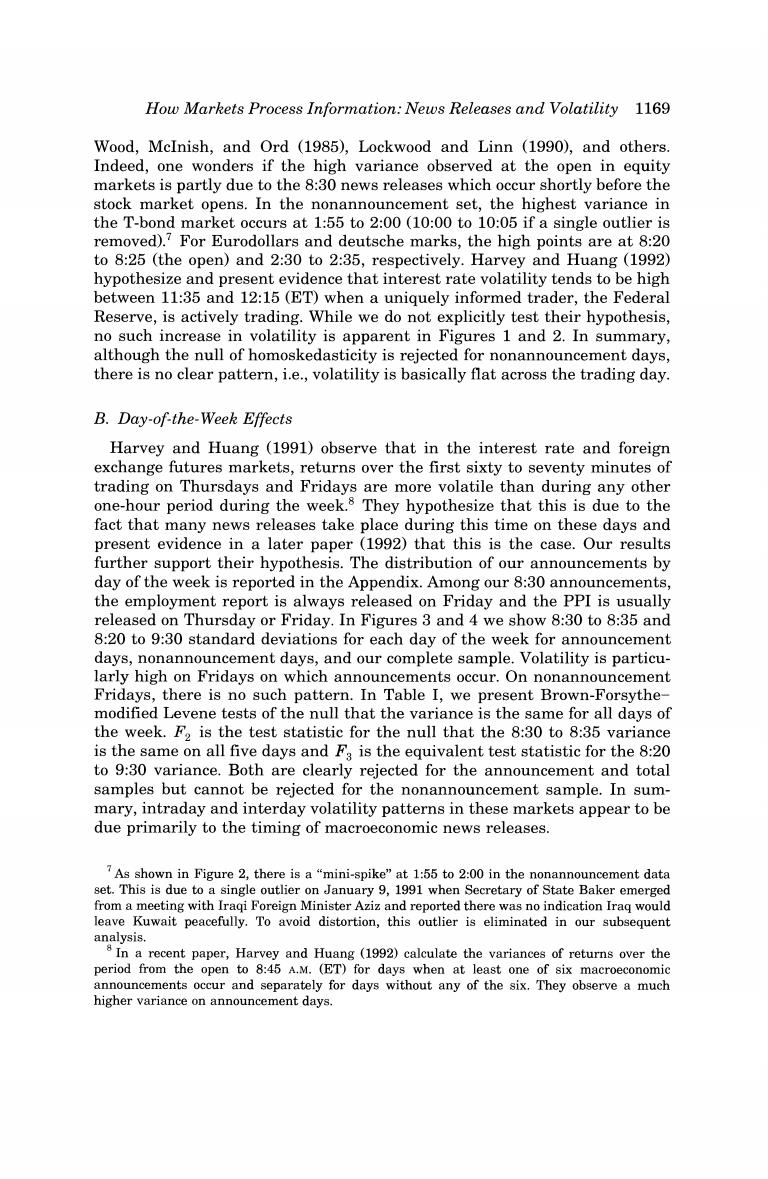正在加载图片...

How Markets Process Information:News Releases and Volatility 1169 Wood,McInish,and Ord (1985),Lockwood and Linn (1990),and others. Indeed,one wonders if the high variance observed at the open in equity markets is partly due to the 8:30 news releases which occur shortly before the stock market opens.In the nonannouncement set,the highest variance in the T-bond market occurs at 1:55 to 2:00(10:00 to 10:05 if a single outlier is removed).?For Eurodollars and deutsche marks,the high points are at 8:20 to 8:25 (the open)and 2:30 to 2:35,respectively.Harvey and Huang (1992) hypothesize and present evidence that interest rate volatility tends to be high between 11:35 and 12:15 (ET)when a uniquely informed trader,the Federal Reserve,is actively trading.While we do not explicitly test their hypothesis, no such increase in volatility is apparent in Figures 1 and 2.In summary, although the null of homoskedasticity is rejected for nonannouncement days, there is no clear pattern,i.e.,volatility is basically flat across the trading day. B.Day-of-the-Week Effects Harvey and Huang(1991)observe that in the interest rate and foreign exchange futures markets,returns over the first sixty to seventy minutes of trading on Thursdays and Fridays are more volatile than during any other one-hour period during the week.8 They hypothesize that this is due to the fact that many news releases take place during this time on these days and present evidence in a later paper (1992)that this is the case.Our results further support their hypothesis.The distribution of our announcements by day of the week is reported in the Appendix.Among our 8:30 announcements, the employment report is always released on Friday and the PPI is usually released on Thursday or Friday.In Figures 3 and 4 we show 8:30 to 8:35 and 8:20 to 9:30 standard deviations for each day of the week for announcement days,nonannouncement days,and our complete sample.Volatility is particu- larly high on Fridays on which announcements occur.On nonannouncement Fridays,there is no such pattern.In Table I,we present Brown-Forsythe- modified Levene tests of the null that the variance is the same for all days of the week.F2 is the test statistic for the null that the 8:30 to 8:35 variance is the same on all five days and Fa is the equivalent test statistic for the 8:20 to 9:30 variance.Both are clearly rejected for the announcement and total samples but cannot be rejected for the nonannouncement sample.In sum- mary,intraday and interday volatility patterns in these markets appear to be due primarily to the timing of macroeconomic news releases. 7As shown in Figure 2,there is a"mini-spike"at 1:55 to 2:00 in the nonannouncement data set.This is due to a single outlier on January 9,1991 when Secretary of State Baker emerged from a meeting with Iraqi Foreign Minister Aziz and reported there was no indication Iraq would leave Kuwait peacefully.To avoid distortion,this outlier is eliminated in our subsequent analysis. 8 In a recent paper,Harvey and Huang(1992)calculate the variances of returns over the period from the open to 8:45 A.M.(ET)for days when at least one of six macroeconomic announcements occur and separately for days without any of the six.They observe a much higher variance on announcement days